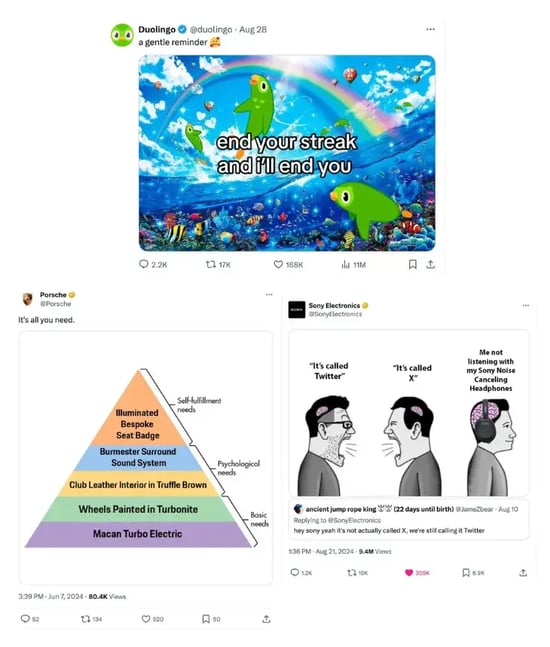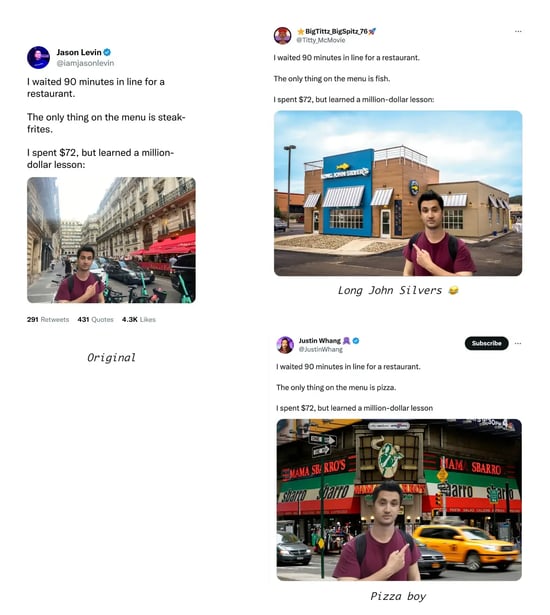Our view at Stack - Simplify growth with an all-in-one platform. Powerful marketing, sales, and support automation. Integrated CMS. Scalable software. Crafted for customer experience.
When most people see memes pop up, they don’t think much about them.
![Download Now: The 2024 State of Social Media Trends [Free Report]](https://no-cache.hubspot.com/cta/default/53/3dc1dfd9-2cb4-4498-8c57-19dbb5671820.png)
“Oh it’s just a stupid meme page,” you might say. “What’s there to think about? What’s the big deal?” But what if I told you some of these “stupid meme pages” are making millions?
And what if I told you it wasn’t just meme pages, but some of Silicon Valley’s hottest startups and the world’s most iconic luxury brands are using memes to make millions, too? Would you start thinking about how to use memes in your marketing too? Of course you would!
Meme marketing leverages the power of humor to get attention on the internet, but humor-based marketing isn’t a new thing. It’s been done for hundreds of years since newspaper ads in the 1700s for magical hair growth potions.
Meme marketing is just the newest internet-native version of it. And it’s been used by the biggest brands in the world — from Duolingo to Porsche, Sony, and more.
As Gen Z and Gen Alpha take hold and become the next class of founders, CEOs, and CMOs, I believe this trend will only continue to grow.
Here’s why you should implement it in your marketing strategy ASAP.

Memes are the highest leverage marketing on earth.
Leverage is all about achieving bigger results with less work.
Meme marketing isn’t some magical get-rich-quick scheme. It’s a lever to pull like anything else. And I think it’s one of the strongest out there.
Think about it. Memes are:
- Free to make
- Fast to make
- An easy way to go viral
What could be higher leverage than that?
When I realized this, I became obsessed with understanding the tricks to meme marketing.
I interviewed every memelord, meme marketer, and meme page operator I could find: a memelord who sold a content agency for $1M+, a growth hacker at a fintech startup worth $100M+ whose main growth tactic has been ads on meme pages to grow it, and a startup founder who drove $3M+ in SaaS sales from viral memes and sold his company for $100M+.
Then, I wrote all about it in my book Memes Make Millions.

But I didn’t just write about the tactics.
I put the tactics into action to prove they worked. I tweet memes like a madman and get millions of views every month.
I went viral and got 26M+ views for a video of me reading meme-y books on the New York Subway. I even went viral in Paris and got turned into a meme!
All this attention has resulted in hundreds of thousands of dollars per year as a marketing consultant helping startups go viral (and blow up the internet).
So, how does meme marketing work?
Step 1. Learn the industry and trends.
If you tried paying me $100k to make memes about hockey, I couldn’t do it.
I know nothing about hockey (except that Canadians are weirdly good at it for some reason). But I can make memes about startups and venture capital all day.
I live and breathe startups. I listen to All-In and My First Million. I go to the tech parties. I read the books. I work with startups all day everyday, and many of my friends are founders/VCs.
I’m on the timeline interacting with people in this world all day. I’m deep in this world. And I can make viral memes night and day.
The takeaway: You can only make memes about industries you’re deep in.
You can make memes about any industry from hockey to gardening to healthcare to startups. The main thing is you need to know the zeitgeist and what’s going on.
Because the meme world is so fast-paced, I actually started a daily newsletter with new viral memes to help people figure out the meme zeitgeist.
Inside Out if it was filmed in my head pic.twitter.com/wi0XsmUGaC
— Jason Levin (@iamjasonlevin)
July 6, 2024
Step 2. Know the problems.
Good memes come from problems your industry faces.
If you look at the best meme pages across finance, tech, whatever, the best memes are typically about problems you’re facing.
If you’re in accounting, you meme about Excel. If you’re in startups, you meme about VCs taking the summers off to party in France.
VCs: “Sorry, we’re still doing due diligence”
The due diligence: pic.twitter.com/WgeU39LgcL
— Jason Levin (@iamjasonlevin)
July 30, 2024
If you’re making memes for your brand, become hyper-focused on what problems your users face. If you’re working on software for writers, you better know what problems writers face (e.g., writer’s block, not enough caffeine, etc.).
Step 3. Know who you cannot offend.
This is something super underrated that most social media managers don’t think about.
It’s actually okay to offend some people. I don’t mean using offensive language like insults or charged words — that’s never okay.
But it is okay to poke fun at a job group like accountants or YouTubers. You just have to be thoughtful and selective about who you’re offending and who you don’t want to ever offend or poke fun at.
For example, at one startup I work with, the product is all about helping founders, so we never try to offend founders. Instead, we pick on VCs (they’re easy targets).
At another startup, the customer was engineers, so we never tried to pick on engineers. Instead, we picked on product managers (again, another easy target).
Happy Mother’s Day to the Product Mommy who single-handedly caused the 2022 recession, the most impactful work she’s ever done pic.twitter.com/7wXfDDpzW6
— Jason Levin (@iamjasonlevin)
May 12, 2024
Step 4. Embrace the cringe.
Is making money cringe?
I don’t think so.
After all, I’ve proved that memes make millions.
Memes are a powerful marketing tactic used by everyone from solo creators to public companies like Netflix. Stop worrying about being cringe, and focus on being funny and making money.
Cringe is the new cool. Become a cringe arbitrageur. When you’re willing to be cringe and do things others are afraid of, you can get so much more attention on the internet.

Step 5. Master the tools.
The tools and software are actually the least important part.
Speed is the most important thing.
Yes, you can use paid software like Photoshop, but you can just as easily use free software like Imgflip or Canva. Really just use whatever is the fastest.
My advice? Don’t overthink the tools.
This isn’t a graphic design job — this is meme marketing. Don’t worry about high fidelity, just focus on being funny. Because remember, in the attention economy, being funny makes millions.
The Takeaway
“Humor is related to strength. To have a sense of humor is to be strong: to keep one‘s sense of humor is to shrug off misfortunes, and to lose one’s sense of humor is to be wounded by them. And so the mark — or at least the prerogative — of strength is not to take oneself too seriously.
The confident will often, like swallows, seem to be making fun of the whole process slightly, as Hitchcock does in his films or Bruegel in his paintings — or Shakespeare, for that matter.” – Paul Graham, Taste
Or as I wrote in my book, “Never underestimate the jester because he may be a king in disguise.”
From the 22-year-old NYC goofball posting finance bro memes to the venture-backed startups making memes about Silicon Valley to public companies leveraging meme marketing — they’re all proof that being silly on the internet can help you make serious money.
![]()
If Hubspot is of interest and you'd like more information, please do make contact or take a look in more detail here.
Credit: Original article published here.
